Overview
- Brief Narrative
- Wooden and cast iron sewing machine table top and base of the type used by Jewish forced laborers in Łódź Ghetto in German occupied Poland from May 1940 to summer 1944. Łódź was occupied by Germany a week after the September 1939 invasion of Poland. It was renamed Litzmannstadt and, in February 1940, the Jewish population, about 160,000 people, was confined to a small sealed off ghetto. All residents had to work and many were forced laborers in ghetto factories. Eventually, nearly 100 factories were in operation. The major ones produced textiles, including uniforms for the German Army. Due to the severe overcrowding and scarce food, disease and starvation were common. The Judenrat [Jewish Council] administered the ghetto for the Germans. Judenrat chairman Mordechai Rumkowski thought hard work and high outputs would preserve the ghetto. But in January 1942, mass deportations to Chelmno killing center began; half the residents were murdered by the end of the year. In summer 1944, Łódź, the last ghetto in Poland, was destroyed and the remaining Jews were sent to Chelmno and Auschwitz-Birkenau killing centers.
- Date
-
use:
1930-1945
- Credit Line
- United States Holocaust Memorial Museum Collection
- Markings
- a. leg, left side, wrought, gold paint : ORIGINAL
a. leg, right side, wrought, gold paint : ORIGINAL - Contributor
-
Manufacturer:
Original Sewing Machine Manufacturing Company
Subject: Mordechai C. Rumkowski
- Biography
-
Mordechai Chaim Rumkowski was born on February 27, 1877, in Ilino, Russia, to Reuven Rumkowski. His brother, Josef, was born on August 8, 1884. He relocated to Łódź, Poland, in the early 1900s, and worked as a merchant and velvet manufacturer before beginning a career as an insurance salesman. In the early 1920s, with funding from the Joint Distribution Committee and other business entities, he opened an orphanage in Helenowek, a Łódź district. He was heavily involved in local Jewish affairs, served on the board of the local Zionist party, and was a member of the Jewish Council.
On September 1, 1939, Germany invaded Poland and by September 8, they occupied Łódź. They appointed an Ältestenrat [Council of Elders] and made 62-year-old Mordechai the Älteste der Juden [Elder of the Jews], a position which gave him a wide range of powers over the Jewish community. He was ordered to choose 31 prominent Jews. On November 11, the Germans arrested the 31 members and they were taken to Radogoszcz prison; eight were released and the rest were murdered. Mordechai formed a second Ältestenrat, which had little influence on Jewish affairs.
The Germans established the Łódź ghetto on February 8, 1940. It was a sealed ghetto, surrounded by barbed wire fencing. Inhabitants were not permitted to leave, except for a small number of forced laborers. This led to overcrowding, starvation, illness, and unsanitary living conditions. Mordechai was appointed the sole administer and answered to Hans Biebow, the head of the ghetto administration. Biebow controlled all activity in the ghetto; he made a profit on slave labor, confiscated property, organized transports to Chelmno killing center, and was active in the destruction of the ghetto. Mordechai was responsible for providing heat, housing, work, food, clothing, and health care. He instituted social programs, issued postage stamps and “Rumkies”, ghetto money printed with his name and signature, performed marriages, and made numerous public speeches.
The Germans required the Jews to pay for their food, housing, and maintenance of the ghetto. Having had their valuables seized and with no way to earn an income, Jews had no money and food was scarce. Mordechai believed that by creating an economically viable and productive workforce, he could spare Jews from deportation and the ghetto from destruction. On April 5, 1940, he requested permission to establish factories using forced Jewish labor. The Germans would supply the raw materials and the workers would make the products and be paid in money and food. The proposal was approved on April 30, 1945, with one change; the workers would be paid in food only. On May 17, 1940, Biebow ordered Arbeitsressorte [work sections] to be set up. By January 1943, there were 96 Arbeitsressorte employing 78,946 workers. The Nazis delivered food that was rationed and inequitably distributed by Mordechai. The amount and quality of food inhabitants received depended on their work status.
On November 17, 1940, Mordechai authorized the founding of the Łódź Ghetto Archives. It became the repository for information regarding the overall history and daily activities of the ghetto. The Chronicle of the Łódź Ghetto bulletin, which detailed life and events in the ghetto and its eventual destruction, was included and censored by Mordechai.
Deportations to the concentration camps began in December 1940. Mordechai cooperated and fulfilled the German set quotas and concentrated on saving the ghetto as a whole. The following year, on December 10, 1941, the Germans ordered 20,000 ghetto inhabitants deported to Chelmno killing center. They ordered Mordechai to select who would be deported. He created the Committee of Five to draw up the list and to hear appeals. On December 27, while working on the list, Mordechai married Regina Weinberger, his legal advisor. They adopted a son, Stanislaw Stein. This was his third marriage; he was twice widowed and his previous marriages were childless. On January 26, 1942, those selected were deported to Chelmno. On September 1942, another mass deportation included the young, old, and ill. In a speech on September 4, 1942, Mordechai told mothers to give up their children. The women refused and the Gestapo stormed the ghetto and brutally removed the children and other deportees. Deportations then ceased for nearly 2 years as the German army was low on munitions and used the forced labor in Łódź to produce the needed goods.
On June 10, 1944, Heinrich Himmler ordered the destruction of the ghetto. Mordechai lied and told the remaining Jews that they were being deported to repair damage caused by air raids. Two deportations to Chelmno followed. On August 4, 1944, the remaining inhabitants were sent to Auschwitz death camp. Mordechai, his family, Jozef and his wife Helene, were on that transport and were murdered. On January 19, 1945, the Soviet army liberated the Łódź ghetto. At its most populated, Łódź had 245,000 internees; there were 877 upon liberation.
Physical Details
- Language
- English
- Classification
-
Furnishings and Furniture
- Category
-
Tables
- Object Type
-
Tables (lcsh)
- Physical Description
- a. Black painted, cast iron, treadle powered sewing machine table base with 2 wrought trefoil legs and a horizontal oval with an embossed manufacturer’s name. The legs are connected by an H-shaped cross brace with a circle and oval design. A large spoked wheel is attached on the right and a rectangular, lattice work treadle is attached near the bottom. Two small metal wheels are attached at the base of the right leg. The rod that connects the treadle to the wheel is missing. Three flat mounting tabs are spaced along the top of each leg where the table top (b.) would be attached.
b. Flat, rectangular, varnished, light brown wooden table top with trim. In the top center is a rectangular hole with a ridge around the center cut and 2 sewing machine mounting notches in the back, covered with frayed orange cloth. Several small holes are drilled into the table top. On the right are a notch and 2 slots; to the rear are 2 circular notches, 1 with a threaded, metal bolt. It would be attached to cast iron legs (a.) for use. The table top is scratched, pitted and stained. - Dimensions
- a: Height: 28.875 inches (73.343 cm) | Width: 23.250 inches (59.055 cm) | Depth: 17.375 inches (44.133 cm)
b: Height: 1.750 inches (4.445 cm) | Width: 38.250 inches (97.155 cm) | Depth: 22.875 inches (58.103 cm) - Materials
- a : cast iron, paint
b : wood, varnish, metal, cloth, adhesive
Rights & Restrictions
- Conditions on Access
- No restrictions on access
- Conditions on Use
- No restrictions on use
Keywords & Subjects
Administrative Notes
- Legal Status
- Permanent Collection
- Provenance
- The sewing machine table was acquired by the United States Holocaust Memorial Museum in 1990.
- Funding Note
- The cataloging of this artifact has been supported by a grant from the Conference on Jewish Material Claims Against Germany.
- Record last modified:
- 2022-07-28 18:21:31
- This page:
- http://collections.ushmm.org/search/catalog/irn4096
Download & Licensing
In-Person Research
- By Appointment
- Request 21 Days in Advance of Visit
- Plan a Research Visit
- Request to See This Object
Contact Us
Also in Eastern European sewing equipment collection
The collection consists of six sewing machines, treadle tables, and a scale used in Poland before, during, and after World War II.
Date: after 1916-before 1950
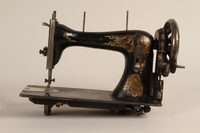
Singer style treadle sewing machine table of the type used in Łódź Ghetto
Object
Treadle sewing machines like this Singer model were used by Jewish forced laborers in Łódź Ghetto in German occupied Poland from May 1940 to summer 1944. This mass produced machine was very durable and affordable. Łódź was occupied by Germany a week after the September 1939 invasion of Poland. It was renamed Litzmannstadt and, in February 1940, the Jewish population, about 160,000 people, was confined to a small sealed off ghetto. All residents had to work and many were forced laborers in ghetto factories. Eventually, nearly 100 factories were in operation. The major ones produced textiles, including uniforms for the German Army. Due to the severe overcrowding and scarce food, disease and starvation were common. The Judenrat [Jewish Council] administered the ghetto for the Germans. Judenrat chairman Mordechai Rumkowski thought hard work and high outputs would preserve the ghetto. But in January 1942, mass deportations to Chelmno killing center began; half the residents were murdered by the end of the year. In summer 1944, Łódź, the last ghetto in Poland, was destroyed and the remaining Jews were sent to Chelmno and Auschwitz-Birkenau killing centers.
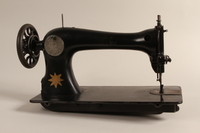
Treadle sewing machine with painted star of the type used in Łódź Ghetto
Object
Treadle sewing machines like this ladies' home model sewing machine were used by Jewish forced laborers in Łódź Ghetto in German occupied Poland from May 1940 to summer 1944. This mass produced machine was very durable and affordable. Łódź was occupied by Germany a week after the September 1939 invasion of Poland. It was renamed Litzmannstadt and, in February 1940, the Jewish population, about 160,000 people, was confined to a small sealed off ghetto. All residents had to work and many were forced laborers in ghetto factories. Eventually, nearly 100 factories were in operation. The major ones produced textiles, including uniforms for the German Army. Due to the severe overcrowding and scarce food, disease and starvation were common. The Judenrat [Jewish Council] administered the ghetto for the Germans. Judenrat chairman Mordechai Rumkowski thought hard work and high outputs would preserve the ghetto. But in January 1942, mass deportations to Chelmno killing center began; half the residents were murdered by the end of the year. In summer 1944, Łódź, the last ghetto in Poland, was destroyed and the remaining Jews were sent to Chelmno and Auschwitz-Birkenau killing centers.
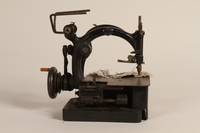
Chain stitch sewing machine of the type used in Łódź Ghetto
Object
Chain stitch treadle sewing machines like this were used by Jewish forced laborers in Łódź Ghetto in German occupied Poland from May 1940 to summer 1944. Łódź was occupied by Germany a week after the September 1939 invasion of Poland. It was renamed Litzmannstadt and, in February 1940, the Jewish population, about 160,000 people, was confined to a small sealed off ghetto. All residents had to work and many were forced laborers in ghetto factories. Eventually, nearly 100 factories were in operation. The major ones produced textiles, including uniforms for the German Army. Due to the severe overcrowding and scarce food, disease and starvation were common. The Judenrat [Jewish Council] administered the ghetto for the Germans. Judenrat chairman Mordechai Rumkowski thought hard work and high outputs would preserve the ghetto. But in January 1942, mass deportations to Chelmno killing center began; half the residents were murdered by the end of the year. In summer 1944, Łódź, the last ghetto in Poland, was destroyed and the remaining Jews were sent to Chelmno and Auschwitz-Birkenau killing centers.
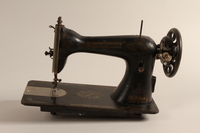
Soviet treadle sewing machine with Singer storage table of the type used in Łódź Ghetto
Object
Treadle sewing machines like this Russian model with Singer sewing table were used by Jewish forced laborers in Łódź Ghetto in German occupied Poland from May 1940 to summer 1944. These mass produced models were inexpensive and very durable. Łódź was occupied by Germany a week after the September 1939 invasion of Poland. It was renamed Litzmannstadt and, in February 1940, the Jewish population, about 160,000 people, was confined to a small sealed off ghetto. All residents had to work and many were forced laborers in ghetto factories. Eventually, nearly 100 factories were in operation. The major ones produced textiles, including uniforms for the German Army. Due to the severe overcrowding and scarce food, disease and starvation were common. The Judenrat [Jewish Council] administered the ghetto for the Germans. Judenrat chairman Mordechai Rumkowski thought hard work and high outputs would preserve the ghetto. But in January 1942, mass deportations to Chelmno killing center began; half the residents were murdered by the end of the year. In summer 1944, Łódź, the last ghetto in Poland, was destroyed and the remaining Jews were sent to Chelmno and Auschwitz-Birkenau killing centers.
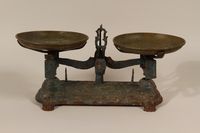
Iron shop store hand scale with two copper trays
Object
Iron measuring scale with two copper trays of the type possibly used in Łódź Ghetto in German occupied Poland from May 1940 to summer 1944. Łódź was occupied by Germany a week after the September 1939 invasion of Poland. It was renamed Litzmannstadt and, in February 1940, the Jewish population, about 160,000 people, was confined to a small sealed off ghetto. All residents had to work and many were forced laborers in ghetto factories. Eventually, nearly 100 factories were in operation. The major ones produced textiles, including uniforms for the German Army. Due to the severe overcrowding and scarce food, disease and starvation were common. The Judenrat [Jewish Council] administered the ghetto for the Germans. Judenrat chairman Mordechai Rumkowski thought hard work and high outputs would preserve the ghetto. But in January 1942, mass deportations to Chelmno killing center began; half the residents were murdered by the end of the year. In summer 1944, Łódź, the last ghetto in Poland, was destroyed and the remaining Jews were sent to Chelmno and Auschwitz-Birkenau killing centers.
Pfaff industrial sewing machine with treadle of the type used in Łódź Ghetto
Object
Treadle sewing machines like this Pfaff industrial model were used by Jewish forced laborers in Łódź Ghetto in German occupied Poland from May 1940 to summer 1944. This mass produced machine was very durable and affordable. Łódź was occupied by Germany a week after the September 1939 invasion of Poland. It was renamed Litzmannstadt and, in February 1940, the Jewish population, about 160,000 people, was confined to a small sealed off ghetto. All residents had to work and many were forced laborers in ghetto factories. Eventually, nearly 100 factories were in operation. The major ones produced textiles, including uniforms for the German Army. Due to the severe overcrowding and scarce food, disease and starvation were common. The Judenrat [Jewish Council] administered the ghetto for the Germans. Judenrat chairman Mordechai Rumkowski thought hard work and high outputs would preserve the ghetto. But in January 1942, mass deportations to Chelmno killing center began; half the residents were murdered by the end of the year. In summer 1944, Łódź, the last ghetto in Poland, was destroyed and the remaining Jews were sent to Chelmno and Auschwitz-Birkenau killing centers.
Singer treadle sewing machine table of the type used in Łódź Ghetto
Object
Singer iron and wood sewing machine table of the type used in Łódź Ghetto in German occupied Poland from May 1940 to summer 1944. Łódź was occupied by Germany a week after the September 1939 invasion of Poland. It was renamed Litzmannstadt and, in February 1940, the Jewish population, about 160,000 people, was confined to a small sealed off ghetto. All residents had to work and many were forced laborers in ghetto factories. Eventually, nearly 100 factories were in operation. The major ones produced textiles, including uniforms for the German Army. Due to the severe overcrowding and scarce food, disease and starvation were common. The Judenrat [Jewish Council] administered the ghetto for the Germans. Judenrat chairman Mordechai Rumkowski thought hard work and high outputs would preserve the ghetto. But in January 1942, mass deportations to Chelmno killing center began; half the residents were murdered by the end of the year. In summer 1944, Łódź, the last ghetto in Poland, was destroyed and the remaining Jews were sent to Chelmno and Auschwitz-Birkenau killing centers.



